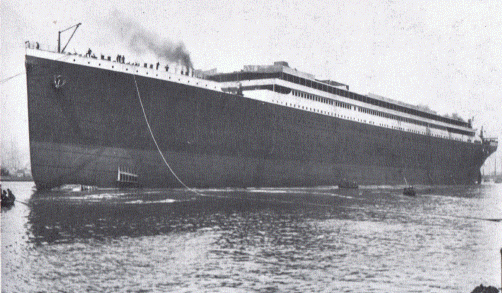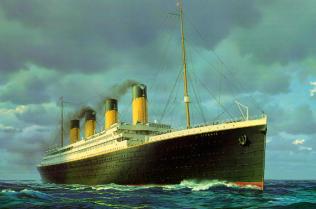 AND THE TITANIC
AND THE TITANICContents | Maiden voyage 1 | Maiden voyage 2 | Maiden voyage 3 | T. H. Ismay | J Bruce Ismay | Allegations of Cowardice | Letters | Sailing Ships
The Ismay Family
THE WHITE STAR LINE
 AND THE TITANIC
AND THE TITANIC


Introduction
There are many websites on the subject of the White Star Line and the Titanic, and many similarities are contained within. I would not suggest that there are no such similarities here, however, you will find information on this website which I believe you will not find on any other. This website is authored and maintained by the Ismay family.
Much has been speculated on why the disaster happened, and of the conduct of J Bruce Ismay. I hope to rebut some of those theories. Joseph Bruce was in fact a great benefactor of the poor. He made many charitable contributions throughout his life, as did his father Thomas Henry Ismay.
I will tell you many facts about the lives of some of the people who made the 'White Star Line' the great shipping company that it was, and some of the events in their lives which were to mould their names into the pages of history.
Formation
Thomas Henry Ismay is often considered to be the founder of the The White Star Line but the Line was actually founded by two partners, Pilkington and Wilson in the early 1850s. Their ships were built of wood. They had done much business during the Australian gold rush and had built themselves an excellent reputation for the transport of emigrants & cargo to the Antipodes. Two of the most famous of the ships were the Red Jacket and the Shalimar. The Red Jacket carried as it's figurehead an Indian Chieftain with a five pointed white star on his chest. it was from this, that the two adopted their house flag. They mounted the white star on a red burgee and from then the line became known as the White Star Line. By 1866 Wilson had his second new partner, Mr. John Cunningham, two years later Wilson & Cunningham owed £527,000, to the Royal Bank of Liverpool when the bank failed. Wilson & Cunningham dissolved their partnership and the firm went into liquidation.
Thomas Henry Ismay bought the White Star flag and the goodwill in 1867 from Wilson for £1000. He then introduced his iron ships into the Australian and New Zealand trade.
Information about further developments of the White Star Line will added in detail at a later date
RMS Titanic
The final
preparations

On March 31, 1909, three months after work started on the first "Olympic-class"
ocean liner Olympic, work was started on the second and most famous of the
three. When J. Bruce Ismay, superintendent of the White Star Line, picked out
her name, he had no idea how famous it would become. He named the ship, Titanic.
For her brief life, Titanic was the largest moving object in the world. She was
even more luxurious than her sister Olympic in that, she had two huge state
rooms, each with it's own private promenade. She also
had an enclosed forward promenade and a restaurant called the Cafe`
Parisien. Although in 1913, Olympic had these
features added to her, for the moment, Titanic was more luxurious.
On May 31, 1911, Titanic was launched. She was put under the command of Captain
Edward John Smith who was captain of Olympic for her first nine voyages before
being transferred to this ship. The maiden voyage of Titanic was to be his last.
After that, he was going to retire. The launch lasted only a minute. It took
many tons of soap and oil to grease the runway that she slid down into the
water. She wasn't christened because it was customary for the White Star Line to
launch without a christening. The next ten months were spent installing
machinery and fitting her interiors. On February 3, 1912 she was dry docked in
the Thomson Graving Dock in Belfast, Northern Ireland where her propellers were
put on and a final coat of paint was applied. At the beginning of March she, for
a short while, joined her sister Olympic, who returned to dry dock for the
replacement of a propeller blade on one of her three propellers.

Premonition or coincidence? but fact!
In 1898, A writer named Morgan Robertson published his latest book. Robertson was the son of a sea captain, he joined the merchant marine service in 1877. He was a popular American writer of sea adventures. This latest book was about a gigantic ship wreck. The ship in the story was an 800 foot steel giant with three propellers, two masts, many watertight compartments, and a top speed of over 20 knots. She was the most luxurious and biggest ship in the world but unfortunately she had too few lifeboats. In the book, the ship was struck by an iceberg on her starboard side at about midnight, sometime in April, and sank in the North Atlantic with a vast loss of life. Robertson named the book, Futility, and he called the ship, the Titan.
Contents | Maiden voyage 1 | Maiden voyage 2 | Maiden voyage 3 | T. H. Ismay | J Bruce Ismay | Allegations of Cowardice | Letters | Sailing Ships
© Clifford Ismay 2004